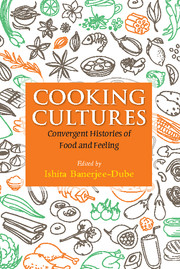Introduction: Culinary Cultures and Convergent Histories
Published online by Cambridge University Press: 05 July 2016
Summary
Lo, the pious are in gardens and delight,
Enjoying what their Lord hath bestowed upon
Them, and their Lord hath protected them
From the punishment of the Hot Place
Eat and drink with relish, for what ye have been doing
(Qu'ran, 1939, 2, Surah 52, The Mount, 536;cited in Peterson, 1980, 321)An intimate association of eating with sensual pleasure in Muslim theology – depicted in the Garden of Delights – had occasioned serious unease in the Christian world that could barely digest the bonding of religion and sensuousness. What caused immense concern was the fact that this ‘philosophy of gratification’ did not only promise joys after death. It spoke of, indeed encouraged, the reaping of pleasure in life by associating good life with good eating (Peterson, 1980, 321). This was in stark contrast to the austerity and temperance demanded of Christians in this life as a step toward an angelic society in heaven (Peterson, 1980, 322). Hence, after the Qu'ran was translated into Latin by the mid-twelfth century, scholars devoted themselves to the task of discerning whether this association was real or allegorical. Others, however, found a different use for this bonding of eating and pleasure in this life. An ‘upheaval’ occurred in the cooking of the European elite from about 1300 CE, accompanied by a marked change in the attitude toward food (Peterson, 1980, 317).
I begin the introduction on this note to divulge, at the outset, an important argument of the book. The volume seeks to explore how food, cooking and cuisine, in different societies, cultures and over different periods of time, are essentially results of confection – combination – of ingredients, ideas, ideologies and imagination, inflected by relations of power and experiments with creativity. Such blends, churned out of transcultural flows of goods, people and ideas, colonial encounters and engagements, adventure and adaptation, and change in attitude and taste, enable convergent histories of the globe kneaded by food and cooking that tell us about being and belonging, pride, identity, hospitality and sociability, class and power, and nation and culture that are ever ready to be cast in different moulds.
- Type
- Chapter
- Information
- Cooking CulturesConvergent Histories of Food and Feeling, pp. 1 - 18Publisher: Cambridge University PressPrint publication year: 2016
References
- 1
- Cited by



